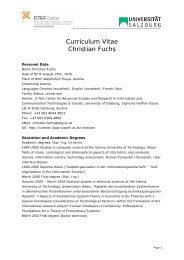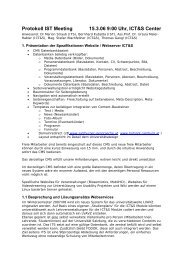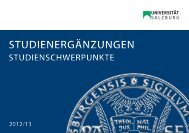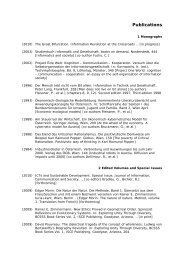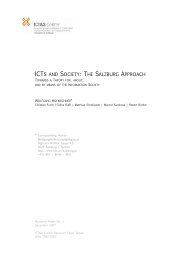CHRISTIAN FUCHS - ICT&S - Universität Salzburg
CHRISTIAN FUCHS - ICT&S - Universität Salzburg
CHRISTIAN FUCHS - ICT&S - Universität Salzburg
Create successful ePaper yourself
Turn your PDF publications into a flip-book with our unique Google optimized e-Paper software.
Christian Fuchs: Social Networking Sites and the Surveillance Societyreinvested and capitalized in order to produce more profit. Capital is accumulated.Commodities are sold at a price that is higher than the investment costs so that profit isgenerated. For Marx, the decisive quality of capital accumulation is that profit is anemergent property of production that is produced by labour, but owned by thecapitalists. Without labour no profit could be made. Workers are forced to enter classrelations and to produce profit in order to survive, which enables capital to appropriatesurplus. The notion of exploited surplus value is the main concept of Marx’s theory, bywhich he intends to show that capitalism is a class society.The capitalist“wants to produce a commodity greater in value than the sum of the values of thecommodities used to produce it, namely the means of production and the labourpowerhe purchased with his good money on the open market. His aim is toproduce not only a use-value, but a commodity; not only use-value, but acommodity; not only use-value, but value; and not just value, but also surplusvalue.(…) The cotton originally bought for £100 is for example re-sold at £100 +£10, i.e. £110. The complete form of this process is therefore M-C-M', where M' =M + ∆M, i.e. the original sum advanced plus an increment. This increment orexcess over the original value I call ’surplus-value’” (Marx 1867/1990: 293, 251;MEW 23: 201, 165).The immediate effects of surplus-value production in class relations are that the productbelongs to the capitalist and not to the worker and that surplus-value “costs the workerlabour but the capitalist nothing, and (…) becomes the legitimate property of thecapitalist” (Marx 1867/1990: 731, MEW 23: 611). If you do not produce cotton, butknowledge, such as for example the Microsoft Windows Vista operating system, thedecisive quality is that knowledge only needs to be produced once and can beinfinitely reproduced at low costs and distributed at high speed. There is no physicalwear and tear of the product, knowledge is not used up in consumption, can bereworked and built upon. There are high initial production costs, but once knowledgeas for example software is produced, it can be cheaply copied and sold at high prices.The constant and variable capital costs for reproduction are low, which is beneficial forsustained capital accumulation in the knowledge industries (Fuchs 2008).The situation again changes a little if knowledge is produced for new media and carriedand distributed by it. A central characteristic of networked digital media is that theconsumer of knowledge has the potential to become its producer. Alvin Toffler (1980)spoke of the emergence of the prosumer within the information society. Axel Brunsapplied this notion to new media and speaks of produsers – users become producers ofdigital knowledge and technology:“Produsage, then, can be roughly defined as a mode of collaborative contentcreation which is led by users or at least crucially involves users as producers –where, in other words, Produsage, then, can be roughly defined as a mode ofcollaborative content creation which is led by users or at least crucially involvesusers as producers – where, in other words, the user acts as a hybriduser/producer, or produser, virtually throughout the production process” (Bruns29



